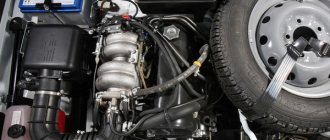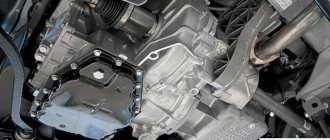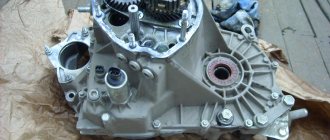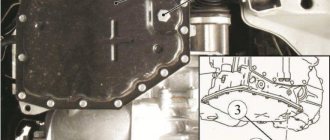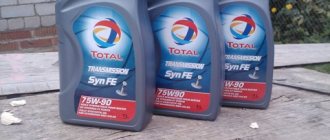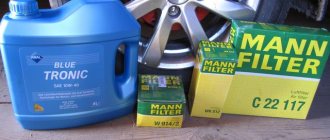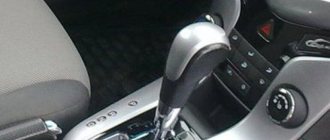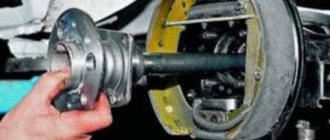The service life and quality of operation of the engine and gearbox directly depend on the correct choice of lubricants. All rubbing and rotating parts must be covered with a layer of oil, regardless of the temperature and intensity of the engine.
NIVA SUVs experience increased loads: “ragged” operation of the engine and gearbox, difficult temperature conditions. The lubricant is supplied to the lubrication units through special channels. If you select its characteristics incorrectly, you may encounter the following problems:
- The thickened technical fluid does not reach the friction unit.
- Due to high temperatures, the lubricant breaks down into fractions and loses its properties.
- Insufficient detergent properties do a poor job of cleaning.
- Poor-quality base or additives themselves become a source of deposits that clog the oil channels.
All this leads to increased wear of engine and gearbox components, and sometimes to crankshaft jamming.
What kind of oil should I put in the Niva?
The most common engine installed on the VAZ 2121 is 8 valves, 83 l/s, volume 1.7 liters . With such a volume, the engine is more torquey than revvy. In this case, the temperature regime is very important - you should choose which oil to pour into the NIVA engine based on weather conditions. The parameters recommended by the manufacturer are only suitable for an engine that has not passed the warranty mileage. There is a table generated based on the requirements src=»https://nivaexpert.ru/wp-content/uploads/2017/02/fig-1-min.jpg» class=»aligncenter» width=»650″ height=»380″ [/img]
Filling with a different lubricant is more expensive for yourself, since you may lose the warranty. Most NIVA owners change the oil themselves after the warranty period, saving money on maintenance. To extend engine life, it is important to choose the correct lubricant viscosity. This parameter directly depends on the weather. The general principle is that the higher the temperature, the higher the viscosity.
The engine is cooled not only by antifreeze, but also by oil. Too thin a lubricant heats up quickly, and heat transfer deteriorates. In addition, it is possible to leak through gaskets and seals. A heated liquid with a low coefficient will not hold the so-called well. grease stain. The other side of the coin is if you fill it with thick oil in winter. Firstly, turning the crankshaft in solid oil is quite difficult even for a fresh battery. Secondly, the viscous lubricant will not pass through the channels, and the level of irrigation of the rubbing parts will be insufficient.
Power unit
The engine installed on the modern model of the Niva 21213 (214) car was inherited from its Soviet progenitor - the VAZ 2121, and in terms of fluid volumes they are almost identical:
- Liquid cooling system. Filled with antifreeze in an amount of 10.7 liters with a freezing point not higher than -40 ° C. The capacity of the interior heating radiator is also included in this volume.
- Crankcase. Motor oils are poured here, the brand of which depends on the operating conditions. Capacity: 3.75 liters, including oil filter filling.
| Lower limit of ambient temperature, °C | -20 | -25 | -25 | -30 | -30 | -15 | -35 | -30 |
| Upper limit of ambient temperature, °C | 45 | 35 | 45 | 35 | 45 | 45 | 25 | 30 |
| SAE lubricant viscosity grade | 15W-40 | 10W-30 | 10W-40 | 5W-30 | 5W-40 | 20W-40 | 0W-30 | 0W-40 |
When flushing the power unit during the process of replacing liquid lubricant, the same amount of flushing oil (3.75 l) is used, taking into account the size of the filter. Replacement is carried out after 8-12 thousand kilometers, depending on the quality of the oil. Flushing is usually performed after 3 engine lubricant changes. During operation, it is important to monitor the oil level in the engine crankcase using a special dipstick. If the level drops below the Min mark, it is urgent to add lubricant to the engine of the same viscosity as was previously filled.
Antifreeze needs to be updated at least once every 3 years or according to the degree of wear of the fluid. It is not recommended to dilute antifreeze with distilled water, either in winter or summer. In winter, the diluted liquid may freeze, and during the summer heat it may boil ahead of time, which will lead to overheating of the engine.
Which oil is better, mineral or synthetic?
We will leave environmental issues to Greenpeace; for NIVA owners, the main thing is reliability. The point is in the base from which the technical fluid is made. Mineral water or semi-synthetic is cheaper to produce, but the resistance to delamination is much lower. On the other hand, replacing transmission fluid on NIVA SUVs occurs quite often; even the most unstable base simply does not have time to lose its factory properties.
The waste consumption of synthetics is higher, since the penetrating ability of such a base is better.
When to replace
All transmission units (manual transmission, transfer case, both axles) are serviced simultaneously. The first time, according to the service book, this must be done after driving 45 thousand kilometers, the next replacement of transmission fluids is carried out when the speedometer shows an indicator of 105 thousand kilometers, then every 60 thousand km. mileage Many owners of this car intentionally or out of ignorance ignore these recommendations, continuing to operate their car after driving one hundred or more thousand kilometers. And then, naturally, they complain about problems with the transmission.
To avoid them for as long as possible (driving 300,000 km on a Niva with regular scheduled maintenance is not a problem), it is recommended to change the oil in Niva axles 2121, 21213, 21214 and other modifications every 50 - 60 thousand kilometers, and when operating the car mainly in difficult conditions - after 30 - 40 thousand.
What kind of oil should I put in the NIVA box?
Since gearbox lubricants are not so expensive, you don’t have to skimp on quality. If you pour frankly cheap fluid of dubious origin, the gear will not engage at the right time. And repairing the box will cost more than the money saved. Just like for an engine, there are temperature tolerances for viscosity.
Parameters in the table.
The box is more sensitive to the quality of fluids, since it operates under increased loads in off-road modes.
Despite the fact that when you buy a NIVA, mineral water is poured into the transmission, at the first replacement it is recommended to flush the gearbox and fill it with synthetics . This does not contradict the warranty, but the box will last longer.
To understand the differences in transmission fluids, watch the video:
Is it worth changing something that lasts a lifetime? The answer to this question disappears by itself when in the backyard of any service station you see a bunch of dead automatic and manual transmissions removed from cars. It becomes clear that gearboxes are now being made disposable. It's easier to replace the whole thing than to try to repair it. Based on this, it follows that the box must be cared for and cherished, and, most importantly, pampered with good oil. And now we will try to find the right oil for Niva 21214.
Reviews
- I started pouring Agip ROTRA MP oil into the transfer case of my Niva. The oil lasts for quite a long time. The transfer case does not hum and creates shocks. There will be a replacement soon, at least I'll see what kind of sediment there will be.
- Instead of factory oil, I decided to fill it with NOVOIL T. I was not familiar with this manufacturer at all before. Having driven in different conditions, the oil did not cause any complaints from me, since the transfer case worked and works perfectly. If this continues to be the case, then perhaps next time I will use this particular oil.
Why does lubrication matter?
Models of this car, such as VAZ 2131, 21213 and 21214, are characterized by the fact that all engine parts are constantly under enormous loads. The reason is that all the parts are rubbing. And when driving outside of asphalt pavement, the service life is significantly reduced. The value of gear oils is quite high. In general, oils are used to prevent rubbing parts from wearing out, as well as to reduce temperature. In rubbing parts the temperature can be about 150 °C, and in chain transmissions where there are teeth it reaches 300 °C. The main criterion for lubrication should be rapid warm-up in cold weather.
Engine lubricant
So, the car owner needed to change the lubricant in the engine. An experienced one will use the one that has already been tested by him. What should an inexperienced car enthusiast do? There are two ways out - search on the Internet or ask knowledgeable drivers. Unfortunately, the opinions of many owners of this car differ greatly. This article will describe one type of motor oil - Shell 10W40. This semi-synthetic product is quite inexpensive, and the reviews about it are extremely positive. The car starts at very low temperatures. To approximately -28 °C. At -30 °C it is simply unreasonable to go anywhere in the field. Since not only oils freeze, but also the lubricating component of the engine can freeze. In principle, you can try Lukoil Lux. Semi-synthetic, almost identical to Shell. But it’s still worse, because many car enthusiasts do not recommend it. The reason lies in the fact that carbon deposits from Shell lubricant are much easier to remove. But for those who will drive Lukoil for a maximum of two or three months, the difference will be insignificant. By the way, it is also necessary to check the oil indicator on the dashboard in a timely manner. There are models of Niva vases that begin to consume this petroleum product excessively. And it has to be topped up every six months. To drain all waste from the engine, it must be warmed up before starting the procedure.
What kind of scratch remover is this?
We constantly receive questions in the comments about what kind of “liquid glass” products this is, and in general what a bunch of auto-related advertising is now on the market. As a result, we decided to test in practice how true this is. Let's just say we used 3 means. One product proved to be so-so; after application, a burnt spot remained in this place. The second product, when applied, showed no effect at all.
The third product, SILANE GUARD, at first it was also felt that there would be no effect. but nevertheless, after the solution remained on the surface for several minutes, the effect was excellent. Of course, everything is not as beautiful as advertised.
We had a discussion at a local service station, they said that the products are effective, but they should be used only according to the instructions. And not as anyone pleases.
Methods for adding lubricant to a domestic vehicle engine
VAZ 21213: oil change in all units
Many car owners are faced with the task of having to perform maintenance on their car. At the same time, some perform the maintenance with their own hands and enjoy the repairs, and at the same time save their money, some prefer to spend money (so as not to get dirty and mess around) and take the car to a car service center, blindly trusting their iron horse to strangers. And, by the way, changing the oil of the VAZ 21213, as in other models, is a responsible process and the service life of all components of the car directly depends on its correct and timely implementation! The replacement process is simply elementary, it doesn’t take much time, and anyone can do it themselves.
Engine
Changing the lubricant in the engine is an elementary process that is carried out according to the regulations either every 10 thousand kilometers, or every two years - depending on what comes first in your case.
Useful tips for the amateur
- Lubricant replacement should be done in a timely manner; the engine life before major overhaul directly depends on this.
- The replacement procedure is best performed on a warm engine.
- It is recommended to fill in the grease of the same brand that was poured into the engine during the previous maintenance.
- If you decide to change the brand of oil, or you don’t know (forgot) which brand was used during the last change, you need to flush the entire engine lubrication system with flushing oil or lubricant of the brand that you will continue to use
- To flush the engine, drain the old grease as described below and fill in the flushing fluid to the bottom mark of the level indicator dipstick
- Then start the engine for 10 minutes, after which we drain the flushing lubricant
Attention: this procedure (rinsing) is performed with the old filter!
Work tool
- Funnel
- A key set to “17” or a hexagon set to “12” (depending on which plug is installed in your pan)
- New oil filter
- Clean rags
- Special filter remover (many people do without it)
- A canister of new oil with a volume of at least four liters
- The empty waste container is also more than four liters
- Overpass or inspection hole
To replace the lubricant in the engine, the instructions prescribe the following actions:
- We drive the car into a pit or overpass
- Be sure to stop the car with the parking brake
- You can additionally place shoes or boards under the wheels (to prevent the car from rolling away)
- Warm up the car engine to at least 50-60 degrees so that the lubricant is more fluid
- Place the drain container and unscrew the plug
Unscrew the plug using a hexagon to “12”
- We drain the waste into a prepared empty container.
- We continue to drain the grease for about ten minutes (so that there is as much glass as possible)
- Screw the drain plug back
- If you are planning to flush the engine, see the steps described above.
Attention: there is about 150-200 grams of lubricant in the filter housing, unscrew it and place a container for processing
- Use a puller or other available means (screwdriver, or just your hands) to unscrew the oil filter
Unscrew and remove the filter
- When choosing motor oil, pay attention to its viscosity
- The manufacturer regulates the viscosity either 5w-30 or 5w-40
- In addition, mineral or semi-synthetic oil is used (when using synthetic oil, in VAZ engines it seeps through the seals and flows out little by little)
- Be sure to lubricate the sealing gasket of our new filter with fresh oil, and also fill it into the filter to about half the volume (which will prevent engine parts from rotating dry in the first seconds of operation)
Lubricate the filter gasket and fill it with grease to half the volume.
- Screw the filter onto the fitting, tighten it 3/4 of a turn by hand from the moment the gasket touches the cylinder block
- Remove the cap from the oil filler neck
- To control the amount of oil being poured, take out the dipstick - level indicator
- A sufficient level of lubricant on the dipstick is located in the middle, between “min” and “max”
Lubricant level marks on the dipstick
- We start the engine, wait for the red lubricant pressure lamp to go out on the dashboard, and stop the engine
- Check the oil level again with the dipstick and add if necessary.
That's all, the engine oil change is complete, this unit requires the most frequent replacement, in gearboxes and axles the replacement is performed less frequently, but do not forget to check its level in all units, otherwise the cost of the issue will be their repair and replacement.
The gearbox is the most stable part of the car. Transmission failures occur less frequently than other parts of the car. The main factor that keeps the gearbox in working condition is the quality of the oil poured into it. The purpose of the gearbox is to transfer power to the drive wheels from the engine by changing the gear ratio and ensuring stable engine operation under different driving conditions.
The oil in the VAZ 21213 gearbox is changed after 60 thousand kilometers. And every 20,000 kilometers it is necessary to check its level in the gearbox and top up if necessary.
The normal level of lubricant in the gearbox housing is located at the edge of the filler hole.
Tools
- Key to "17"
- Hexagon on "12"
- Rags
- Processing container
- Syringe for filling oil
The replacement procedure occurs in this order:
- We carry out the work by driving the car onto a pit, overpass, or lift
- You must first warm up the chassis by driving about ten kilometers.
- Using a hexagon on “12”, unscrew the drain plug and drain the lubricant into a container prepared in advance
Using a hexagon, unscrew the drain plug
- After lubricating the glass, use a rag to clean the magnet of the plug from dirt and metal particles and screw it back in
Clean the drain plug with a rag and screw it back in
Unscrew the filler plug with a key set to “17”
- We fill in new gearbox oil with a syringe to the bottom edge of our filler hole (the front driveshaft is removed in the photo for clarity)
Fill the gearbox with lubricant using a syringe
- Screw the filler plug back
This completes the oil change in the box of the VAZ 21213, without any difficulties.
Transfer case
The transfer case transmits torque from the engine to the rear and front axles, allowing you to turn on both axles at the same time, or one of the two as needed.
Tool
- Hexagon on "12"
- Rags
- Tube (lever to make it easier to rotate the hexagon)
- Container for waste grease
- Oil filler
The oil change is performed simultaneously with the gearbox, after 60 thousand kilometers. Replacement procedure:
- Performed on a lift, overpass or pit
- Pre-warm the transmission after driving less than 10 kilometers
- Unscrew the plug with a hexagon “12” and drain the used lubricant
Unscrew the drain plug
- Clean the magnet of the plug and screw it back in
- Then use the same hexagon to unscrew the filler plug.
Unscrew the filler plug
Fill in fresh lubricant with a syringe to the level of the bottom edge of the hole.
- Checking the level - the hole is the lower edge of the filler hole
- Be sure to clean the breather from dirt, which is located on the side of the rear cardan (for clarity, the breather is shown on the removed box)
That's all for replacing the lubricant in the transfer case.
Rear axle
The oil in the rear axle is changed every 60 thousand kilometers, as in the gearbox. Check the lubricant level in the crankcase every 20 thousand kilometers and top up if necessary. A sufficient level of lubricant reaches the edge of the filler hole. When checking the level, do not forget to clean the breather from dirt in the same way as for the transfer case.
- Socket wrench "17"
- Key to "13"
- Oil filler syringe
- Rags
- Hexagon on "12"
- Processing container
Sequence of the procedure:
- The work is performed on a pit, lift or overpass
- We pre-warm the bridge by driving about ten kilometers
- Using a 12" hex wrench, unscrew the drain plug.
- Drain the oil into the prepared container
Unscrew the drain plug and drain the lubricant into a container
- We clean the magnet of the plug with a rag from dirt and metal particles and screw it back
- Using a socket wrench set to “17”, unscrew the filler plug.
- Fill in new oil with a syringe, up to the edge of the filler hole.
Using a syringe, pour lubricant into the bridge
- Screw in the filler plug
- Unscrew the breather with a wrench at “13”
- We clean the breather, screw it into place
Congratulations, the oil change on the VAZ 21213 has been successfully completed, now you can carry out maintenance of your car yourself. Additionally, you can watch a video about each unit separately.
Transmission Lubricant
The transmission consists of:
- Front axle
- Handouts
- Rear axle
- Gearboxes
Changing the oil in the gearbox, axles and transfer case is not much different in complexity from changing the lubricant in the engine. The only thing that can be replaced less frequently is once every 750 km, or once every 5 years. But not all car enthusiasts pay due attention to replacing the oil component. And this is a very important procedure, because the gearbox can become unusable, and then the bridges and transfer case. For winter it is necessary to select species with lower viscosity than in summer. Therefore, 70v90 is, after all, better suited for the winter period, since it has a fairly low viscosity. You should also know that synthetics are thinner than mineral water. Where and what kind of petroleum product to pour? On this issue, the opinions of car enthusiasts differ. Some advise pouring one lubricant into the front and rear axles, and another into the gearbox and transfer case. Others pour the same lubricant into both the gearbox and the axles. Actually, if during the ride you will cross small bodies of water, then it is better to pour a thicker one, since it will be diluted with the water that gets in. In winter, it will be best to fill with inexpensive semi-synthetic - TNK 75W90. It is suitable for both the Niva 21213 and the VAZ 2131. Replacement can be carried out at a service station. For this procedure you will have to pay about 2500 rubles. But if you have enough experience and knowledge, you can carry out this procedure yourself. Car service workers who have such a car advise TNK, but if you want to fill up with a more expensive one, then SHELL SPIRAX is the best choice.
Transmission oil for Niva GL4+
synthetics GL4+
In addition to clear tolerances, there are so-called combined tolerances. Once upon a time this practice was started by the VAG concern. The oil meets both GL4 and GL-5 tolerances. These products contain a very large number of additives. By definition, they cannot be mineral-based. In the article about motor oils, I already said that in Russia there are a few very high-quality products that are worthy of attention. Relatively recently, at the request of AvtoTAZ, Lukoil made a service product. I’ll immediately decipher what “service” is. This means that it should not be supplied to the retail network; it can only be used by an official dealer or representative. Product viscosity 75-90, synthetic base. In this case, transmission oil for Chevrolet Niva and Niva is valid for the entire transmission. You can pour it into all nodes, from the “tip of the nose to the tip of the tail.” The canister has a capacity of 4 liters, that is, just enough for 2 gearboxes and a transfer case. If you also count on the gearbox, then you need to either look for a “liter” or take another “four”. At the price per liter of oil, this product is unbeatable.
Changing the gearbox lubricant
In order to carry out a replacement in the gearbox, you will need some tools, an inspection hole or overpass and, in fact, the lubricant itself. Once you get under the car, you need to place some kind of container under the drain hole. Next, you need to take a hex wrench and unscrew all the bolts on the drain plugs. After all the waste has drained, you need to take a magnet, which is specially installed on the box. This device removes all metal debris. An important point is that the more metal particles, the shorter the life of the car. Now you need to flush the crankcase. This procedure is performed using a special liquid. Fill it with about 1 liter, screw in the cap, and then start the engine and let it run for about 5 minutes. During this, you need to turn on the neutral gear and shift in ascending and descending order. After this, you need to drain all the liquid and add lubricant. And then you need to start the car, put it in first gear and leave it for five minutes.
Changing the oil in the rear axle gearbox
How often do you change the oil in the rear gearbox? — According to the service book regulations, the oil in the gearbox is changed every 40 thousand km.
If the car is new, then the first replacement should be after 2 thousand km, and then every 40 thousand km. How much oil should I put in the rear gearbox? - 1.3 l.
What kind of oil should I use? — Gear oil quality according to API GL-5 and viscosity 75W-90
(for more details about specific brands and characteristics of oil, see Liquids used and filling volumes)
Checking the oil level
You need to check the oil level every 10,000 km. on a cold gearbox.
Using a spanner wrench, unscrew the filler plug. The oil level should reach the bottom edge of the filler hole, which can be checked with your finger. If there is insufficient oil, add it as shown below until it starts to leak. After draining the excess, screw the plug back into place.
Change of oil
We carry out the work on an inspection ditch or a lift. Before changing the oil, you need to warm it up by driving the car for at least 10 km.
|
|
We clean the magnet of the drain plug and wrap it.
Using a 17mm spanner, unscrew the filler plug.
|
We wrap the filler plug.
Using the key “13” we turn off the breather.
We clean the breather and wrap it in place.
Video
Source
How, where and what should be poured into the transmission?
In order to properly fill the transmission with lubricant, you need to know the types of oils that are suitable in viscosity for a particular season. Winter types are used not only in winter, but also in summer. In Russia this is most common, since it is more often cold than warm. In order to choose the right and good lubricant, before replacing you need to follow a few tips:
- Before choosing any product from oil companies, you need to review their composition and recommendations for use.
- You should not choose the most expensive lubricant, because replacing the recommended oil with this may negatively affect the operation of the lubrication system.
- Untimely replacement of lubricant is a sure step towards rapid wear of automotive components.
- The greater the mileage of the car, the harsher the operating conditions. This means that the lubricant must be replaced much more often than in almost new cars.
- The oil sensor must be in good working order and the lubricant level must be constant. If for some reason the level drops, then more lubricant must be added.
Changing the oil is quite important for the VAZ Niva SUV. Each type of car requires its own type of lubrication, otherwise problems with the systems may occur. Or, in the worst case scenario, some part may fail.
Car maintenance: adding lubricant

